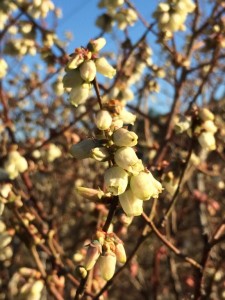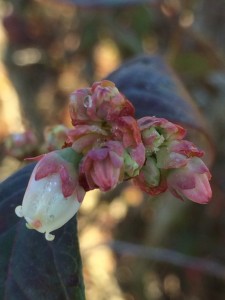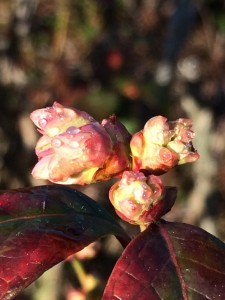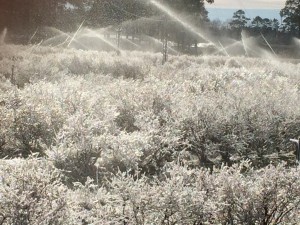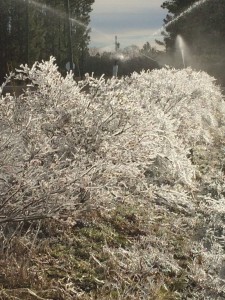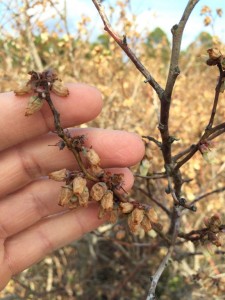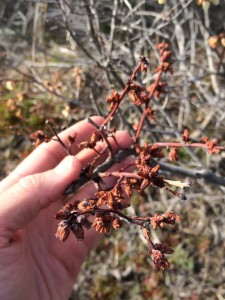On February 12 blueberries looked like this:
On February 13 blueberries looked like this:
And the below pictures were taken on February 23. You can easily see the freeze damage in the blueberries even though this field was freeze protected.
Why are we seeing damage if the plants were protected?
In using overhead irrigation for frost/freeze protection the heat lost from the plant part to its environment is replaced by the heat released when water changes to ice. Specifically, as one pound of water freezes, 144 BTU’s of heat energy are liberated. This is called the latent heat of fusion of water. As long as liquid water is freezing on the plant at all times, the surface temperature will remain at or near 32° F. But, adequate water must be applied to compensate for heat losses by radiation, convection and evaporation.
The irrigation rate is very important. If the irrigation rate is not adequate, the damage may be more severe than if no protection had been provided. If wind velocities are high and/or if the relative humidity is low, water may evaporate from the plant surfaces. If this occurs, evaporative cooling will actually lower the temperature of the plant. As one pound of water evaporates 1080 BTU’s of heat energy are absorbed from the surrounding environment. When compared to the 144 BTU’s released by freezing, it becomes apparent that 7 ½ times more water must be freezing than evaporating in order to have a net heating effect. For this reason, frost/freeze protection by irrigation is not usually recommended if wind velocities exceed five miles per hour. If the relative humidity is low, the sprinkler system should be started at a higher than usual temperature to compensate for the evaporative cooling that will occur as the first water strikes the plants.
The amount of water applied from overhead sprinkler systems can vary, but usually they use about 60 to 72 gallons per minute per acre (4,320 gallons per hour). For freeze protection the system is started when the temperature has dropped into a range of 33 to 38 F and the grower expects the temperature to reach a minimum below 28 F before warming begins after sunrise. The system has to run until temperatures are above freezing. This could be 12 hours multiple times a week depending on the weather. That equals 51,840 gallons per acre in a 12 hour period.
To protect plants against much colder temperatures and higher wind speeds, systems should be designed for higher water volume applying .25 to .4 inches per hour. This is 6,788 to 10,861 GPH. A system applying .4 inches per hour can protect a blueberry field down to 18 F with winds speeds 4 MPH or lower. However, very few systems can supply that kind of water volume. Just to further explain how much water that is, a 12 inch well pumps 1,000 GPM or 60,000 GPH. If a grower needed to apply .4 inches per hour, one 12 inch well could only protect 5.5 acres. Of course, a lot of growers use ponds to pump from, but you can still understand the volume of water it would take once wind speeds increase. When we experienced the high winds and freeze more damage occurred in fields that attempted to freeze protect and had an inadequate water supply.
